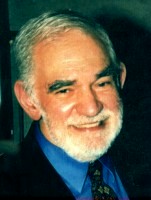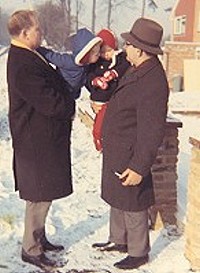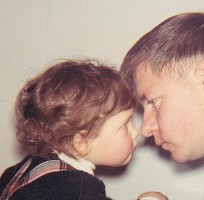WILLIAM RUSSO
A Tribute
by Ron Simmonds

Jazz and classical music
The influence of Ellington
Tribute
Coming out of the Marquis Club after one of our Sunday jazz sessions I saw Bill Russo standing by the door talking to Tony Russell. I knew Bill’s face because he had been one of the trombone players in the Stan Kenton band when they visited Dublin. He had also been responsible for most of Kenton’s arrangements at the time, including the stunning Fascinating Rhythm, which musicians still talk about to this day.
Bill had come to London under a Koussevitsky Grant and was looking for musicians to start a London Jazz Orchestra. I said that he couldn’t think of doing such a thing without having me in the band. He agreed at once, and just having heard the Dankworth band he also asked several of the other guys to come along as well. So we had Kenny Wheeler, Leon Calvert, Tony Russell and Art Ellefson there right from the beginning.
I think it’s worth giving the line-up of the London Jazz Orchestra here, because although I’ve frequently damned the British big bands as never attaining the musical perfection of their American counterparts, this orchestra was the one and only exception. Listening to the recordings and BBC tapes today, thirty years later, it is clear that Bill Russo’s music brought performances from the musicians of a standard and quality never demanded by any other arranger or bandleader in the country.
Obviously, the British musician had much more to offer than was generally demanded of him, and he was quickly adaptable, because Russo’s music had to be played in a quite unusual way, and Bill was pedantic on this. Style of phrasing, length of notes and dynamics were all carefully detailed and discussed. Some of the music had been specially written as a means of learning these innovations, including an ingenious composition by Bill that helped everyone to get absolutely in tune.
The four trumpets, five trombones and five saxes were divided into two separate units, with, facing the orchestra, the lead instruments over on the left. The rhythm section and strings sat in the centre. As recording was done on only two microphones the internal balance had to be perfect, and it was, absolutely. Kenny Clare, in particular, sitting right in the middle of us on drums, with no screens, had to take it very easy.
The personnel: Ron Simmonds, Leon Calvert, Gordon Rose, Kenny Wheeler or Tony Mabbett (trumpets)
Johnny Edwards, Don Lusher, Bobby Lamb, Keith Christie or Tony Russell, Jack Thirlwall (trombones)
Johnny Scott, Al Newman, Duncan Lamont, Art Ellefson, Ronnie Ross (saxes)
Ray Dempsey (guitar), Arthur Watts (bass), Kenny Clare (drums)
Raymond Clark, Derek Simpson, Hilary Robinson, Jack Holmes (‘cellos)
Richard Morgan (oboe)
The rehearsals, recordings and BBC tapes were all made in the Lansdowne Studios in Ladbroke Grove. Richard Peaslee, Johnny Scott and Tony Russell wrote some brilliant scores for the orchestra which were also recorded. The saxophones in all of the works we performed were particularly outstanding. Sadly Jack Thirlwall, Ronnie Ross, Keith Christie, Arthur Watts and Kenny Clare are no longer with us as I write this. The recordings are a lasting tribute to their perfection.
It wasn’t swinging music as we knew it, à la Basie or Herman, but I learned a lot about the American way of playing from Bill, which I put to good use in all the other work I was doing. I became very friendly with him, and used to run him home to Kensington after the rehearsals, which ran from eleven at night until three in the morning on Monday nights. This was the only time that we could all guarantee being free from studio obligations.
Back in his house in Kensington we’d eat supper and talk about music. This was a thrilling experience for me, and I got all kinds of information about the Kenton band out of him. Apparently that band almost had to fold several times because of the trouble some of the wives were making. It sounded like the script for Glenn Miller’s Orchestra Wives, only much, much worse.
Bob Burgess, who was on lead trombone with Kenton at the time, confirmed this to me many years later. He also said that the guys in the Kenton band hadn’t liked Bill’s arrangements too much. They all wanted to play swinging stuff like Woody Herman. But the records Kenton made with Bill’s scores sold more copies than anything else Stan or Woody ever turned out.
Bill was quite strict
on discipline in the London Jazz Orchestra, and even fired a couple
of the guys for being late, even though we weren’t getting paid for
it. He used to wear a huge 1920’s gangster hat, the kind George Raft
wore in Some Like  it
Hot. In keeping with the dignified air of the proceedings the
recordings were titled: William Russo conducts the London Jazz
Orchestra, with an added Leader, Ron Simmonds, which I thought
was a hell of a compliment.
it
Hot. In keeping with the dignified air of the proceedings the
recordings were titled: William Russo conducts the London Jazz
Orchestra, with an added Leader, Ron Simmonds, which I thought
was a hell of a compliment.
The only time I invited Bill and his wife Jeremy around to my new house in Bushey Heath I fell asleep immediately after dinner, and slept right through until it was time for them to leave some three hours later.
I wasn’t the only one doing this, because other musicians would come to dinner at my place and they would fall asleep afterwards, notably the trumpet player Alan Franks, who used to snore like a motor mower.
The pictures were
taken at my house in Bushey Heath in the winter of 1962. Bill and Jeremy
had named Condee (Countess) after Conte Candoli, known by all as The
Count. The Kenton band had already recorded Bill's Portrait of
a Count with Conte, now we had recorded a new version with the London
Jazz Orchestra and Leon Calvert  playing
the solo trumpet. (Hover your mouse over each picture for the captions).
playing
the solo trumpet. (Hover your mouse over each picture for the captions).
All of the things we recorded differed from the Kenton versions—Bill's Blues, for instance, had been rescored in 5/4. Bill gave me a copy of the score when I left for Germany and I was able to analyse it at leisure. Some remarkable things emerged. I learned how he had created that stunning sound he called the Gazelle, used in You and the Night and the Music on Kenton's Portraits on Standards and several other of Bill's scores. I also discovered how he used added tones, notes not in the chords or chord extensions, to create new sounds. When his second book was published, called Jazz Composition and Orchestration, he sent me a copy. I remember taking the book, early one morning, down to one of Berlin's sandy beaches. There I sat all day, enthralled by what I was reading, until darkness came. Looking back, though, I probably learned more from that one score of Bill's Blues than I did from the entire book.
When Bill was writing the book he had a huge notice board fixed to the wall of his study. Hundreds of small pieces of paper containing his notes and hastily jotted bits of scoring were pinned to the board. While I was in there one day, on holiday from Germany, he borrowed a second tape recorder and made me a copy of our BBC transcription tapes—never issued on disc. There is a jolt on the tape, right in the middle of My Man's Gone Now, where his daughter Condee tripped over the connecting wire. I told him to leave it in. It is a part of history now.
These were pretty heady days for me. Here I was, talking on a regular basis to one of my idols, a man who had not only written for, but also played in one of the bands I had always greatly admired. In later years I was to meet many of the players in that band and work with them, including Kenton himself, but this was pure magic. I don't know—the other guys in the London Jazz Orchestra must have felt the same—I certainly hope so, but I have a feeling that it hit me the hardest.
Jeremy and Bill invited me around to dinner one evening. The talk was of Stravinsky, Ravel, Bach—and Hindemith. Paul Hindemith had had a great influence on Bill, right from his early years. When he and Lee Konitz studied with Lennie Tristano they weren't getting a jazz education—they were being taught the fundaments of classical music. After dinner that evening we sat around talking. Bill suggested that we sing something together, and produced some part writing by Hindemith. They had obviously done this before with others. I was not used to singing; I read what was before me, but pitching the notes was out of the question against the counterpoint they were singing.
"Good training," said Bill. "If you can do that you can do anything. You'll hear the harmonies horizontally and they will flow on to the paper."
After we recorded Russo in London Bill gave a party in his house to celebrate. All the wives were there, and they could finally see and hear what we had been up to all those late Monday nights. The record was superb. When the celebrated pianist and record critic Steve Race heard it he dismissed it out of hand. Here's what he had to say.
WILLIAM RUSSO DISAPPOINTS
My first musical introduction to Bill Russo—or William, as he now likes to be called—came something like a decade ago in an LP called “Stan Kenton Showcase”. The compositions on one side featured the capable, but to my mind strictly limited, talents of Bill Holman. On the other side were the sombre, imaginative scores of Kenton trombonist Bill Russo.
For the past year Russo has been living in London, rehearsing an all–star orchestra of top British session men. His life must have been not unlike that of the composer Haydn, who had only to ring a bell for an orchestra to assemble and try out any new scoring notion which had come into the Master’s mind.
Now, on a Columbia long–player, we have the fruits of this international partnership. Titled “Russo in London”, it consists—to my mind somewhat surprisingly—of old Russo compositions which are already available on other recordings. We all know that Louis Armstrong plays the same old repertoire year in and year out, but surely Bill Russo has thought of some new material in the past 13 years? One knows he has, of course. So why not record it? Russo LP albums are not so common that a whole one can be devoted to the re–thinking of old thoughts.
The music is almost unremittingly sombre in mood, and frankly tiresome in its addiction to chords based on superimposed thirds. For much of the time the trombone choir offers a succession of minor 9th and 11th chords.
The ensemble is seldom exciting, the rhythm section tends to be slack, and only Russo himself can explain why a band which includes Art Ellefson and Don Lusher should feature as tenor and trombone soloists only Duncan Lamont and Keith Christie.
To speak bluntly, I found the record a disappointment and little short of a bore. Jazz can do without serious– minded composers if they are going to take away its zest and substitute nothing but an addiction to minor sonorities. Steve Race
Ah, yes! The strictly limited talents of Bill Holman....
We recorded Bill’s opera John Hooten before I left for Germany, and he got Annie Ross over from the States to sing on it. Later on he wrote his English Concerto, and I came back from Munich to play on that one. It was a violin concerto, written primarily for Yehudi Menuhin.
When I turned up at the studios in Ladbroke Grove there were dozens of classical violinists hanging around outside. I recognised some of them. They said they were waiting to hear Stevyn Staryk. Once inside the studio Bill told me that Menuhin hadn’t been able to handle the concerto, and had messed about playing snatches of Yankee Doodle, seeming to regard the whole thing as a joke. But the music was very difficult for everyone, having been written with an unusual time sequence which had probably thrown him.
Bill had coaxed Steve away from his job as leader of the Chicago Symphony orchestra to make this recording. They were pals, and Steve was also regarded as one of the leading violinists in the world. Of course he played the concerto superbly.
I was playing a lot of sessions in those days, studio work with the cream of the London musicians. Some of them complained to me about my new method of phrasing. What I was really doing was to apply what I was learning from Bill in my daily work. I was now playing the American style of phrasing and to most of them it was entirely new. Only the ones who were learning alongside me in the Russo orchestra: Don Lusher, Johnny Edwards, Bobby Lamb and some of the sax players, knew what I was doing. But I persevered, and most of the guys who were complaining soon managed to figure out the hows and the whys. But, for a while, Bill Russo received quite a few curses behind his back, because we were making the British musician sit up and pay attention.
Today quite a lot of people with whom I worked in the past tell me that I always played more like an American lead player than anything else. I like to think that my time with Bill helped me along in that direction, although my avid listening to American bands on record, and the influence of some of the people I worked alongside had also rubbed off on me by then. I had been immensely impressed with the way Tommy McQuater played, for instance, and by the sound produced by Bert Courtley - for me that was the ideal American trumpet sound. Bert used to project the notes from his horn - they virtually sizzled out! I really admired that. And Jimmy Deuchar. What a player that man was! I was listening all the time and I garnered a little from each of them. Ron Simmonds, January 2003
Copyright © 2003, Ron Simmonds. All Rights Reserved.
Parts of this tribute were taken from Ron's Pages